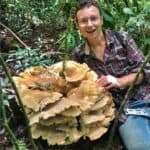Table of Contents
Every mushroom species has an accepted scientific name which has two parts. The first of which relates it to a larger genealogical classification known as the genus. The second part called “the specific epithet” is a unique title that follows the genus.
Scientific names are important because:
- They allow for communication across cultural boundaries. Here, common names may be different or non-existent.
- They define the genetic and morphological boundaries of an organism.
- Different species, many share a single common name.
- Scientific names have valuable information about the genetic lineage.
So what are Scientific Names?
Every organism known to science has a scientific name. They are always composed of 2 parts and italicized when written. For example, Homo sapiens is the scientific name for the human species.
The two parts that make up the scientific name are the genus (ex. Homo) and the specific epithet (ex. sapiens).
- The Genus -This is a higher classification that contains many species. In Homo sapiens, the genus is Homo, which contains our species and other extinct species. For example, our distant relative the Neanderthals have the scientific name Homo neanderthalensis. Once a scientific name gets used in a text, the genus is abbreviated to the first letter (ex. H. sapiens).
- The Specific Epithet –This is the second part of the scientific name that specifies the species within the genus (ex. sapiens).
Some Scientific Names and common Names of Mushrooms
| Scientific Name | Common Names |
| Pleurotus ostreatus | Oyster Mushroom |
| Pleurotus djamor | Pink Oyster Mushroom |
| Pleurotus cornucopoides | Yellow Oyster Mushroom |
| Agaricus bisporus | Button Mushroom, Crimini, Portobello |
| Hericium erinaceus | Lions Mane, Pom Poms |
| Flammuline velutipes | Enoki |
| Ganoderma lucidum | Reishi, Lingzhi |
| Cantharellus formosus | Golden Chanterelle |
| Cantharellus cibarius | Golden Chanterelle |
| Cantharellus atrolilacinus | None |
| Lentinula edodes | Shittake |
| Amanita muscaria | Fly Agaric, Mario Mushroom, Amanita |
| Boletus edulis | Bolete, Porcini, Cep |
What does “sp.” mean in a Scientific Name?
This is an abbreviation for species. When you see “sp.” following a genus, this means the author is referring to an unspecified member of the genus. This is usually because the identification of this species is uncertain or undescribed.
Can a Mushroom have multiple Scientific Names?
No species should have multiple scientific names, but it does happen.
This occurs when:
- The same species is scientifically described many times under different names.
- There is a dispute amongst the scientific community. For example, you will see the species “Blewit” as either Lepista nuda or Clitocybe nuda.
Are there Mushrooms without Scientific Names?
Yes! Tons of them! These are mushrooms that have yet to be scientifically described. To do this, a scientist must prove why it is different from other described species. Scientists do this with detailed morphological descriptions and DNA evidence.

